Elephantus, Felis, Canis, Oh My!
Saturday, June 24, 2006
We FINALLY splurged on a language course from
The Rosetta Stone company. We have been lusting for a chance to use one of their products and we finally took the dive.
They have a
special subsection geared to homeschoolers that seems to be a good deal.
The Rosetta Stone language software concept is good for kids who are used to sitting in front of the computer and lack sensation in their behinds *winks* (ok, I really mean, have the computer skills), like to do high tech things for themselves and troubleshoot if need be (there really is no need with this software but it's a good attitude to have in the learning phase for getting acquainted with the user interface, which is very simple), and like to go through the program at their own pace (what kid doesn't?!).
We thought about getting the Spanish or French but we decided on the Latin 1 course.
 (Image source: Rosetta Stone)
(Image source: Rosetta Stone)
Level 1 Includes:3,500+ real-life images and phrases in 92 lessons
More than 300 hours of instruction
Speech recognition for accent perfection
Systematic structure teaches vocabulary and grammar naturally, without lists and drills
Previews, exercises, and tests for every lesson with automated tutorials
Written ancillary materials
Why Latin? Well, if Q were to get that invite to festivities at the Vatican next year, she will be prepared. She will also get a firm foundation in the root romance language. Q could pick up on that right away when she said that some of the words reminded her of disease names.
Q especially loves the verbal exercises where she speaks into the microphone we got her and the software lets her know how close it gets to the example sound profiles.
Before we knew it Q had spent hours practicing vocabulary and grammar.
I knew it was a mega-hit when the 3 year old was walking around the room chanting words like "Felis" out loud.
Homo sapiens spongificus, our children.
PS: I don't really care who recommends this product (you will see some of that on the homeschool specific pages) because, as with ANY product, we do extensive research but do not look to these awards and recommendations for real honest input. We figure we will risk the money on the first try and then use it again if it is worth it.


::
>
Phylogeny - Tree of Life
Tuesday, June 20, 2006
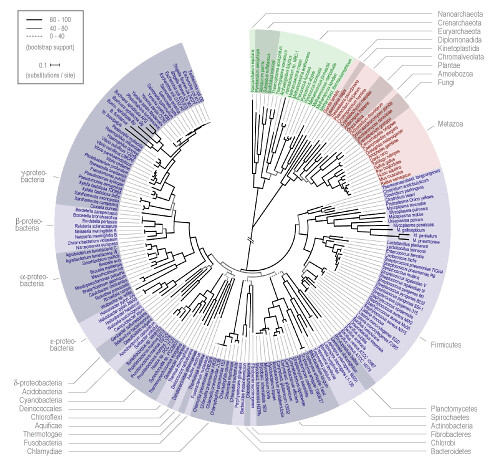 (Image Source: Tree of Life)
(Image Source: Tree of Life)Since I used some big words and concepts without explanation in
my last post about the Sarcophaga sp. fly, I thought I would do a little discussion with links here about Phylogeny and the Tree of Life.
Humans have always been driven by curiosity to learn about the world around them. After making some observations about a particular living thing, a name is needed for that thing to be able to communicate your findings to other people. For this reason, the naming, description, and characterization of all the species known to us started early on. With time, relationships between various animals and plants became part of how that thing is described. So first generation "maps" of being-to-being relationships began to be made and shared in the growing neo-scientific communities.
Second generation maps began to form with a growing understanding of the developmental changes in animals over time to form new species or distinct types of animals or plants that can not breed outside of their species group.
Thus, today, we have many maps of our natural world. A good link to one of these can be found at:
The Tree of Life Web Project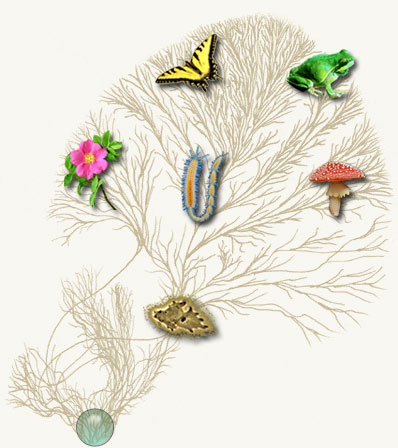 (Image Source: Tree of Life)
(Image Source: Tree of Life)As there are something like 1.8 million described organisms, drawing a truly representative map of our biological world can be difficult. A site that serves as an index of some of the
more successful maps is found at this link.
Here is an example of a dynamic space filling model of an evolutionary map. This was generated by the
WALRUS modeling program using data from all organisms cataloged on the
NCBI taxonomy database, which currently contains approx. 180,000 nodes
 (Image Source: WALRUS model)
(Image Source: WALRUS model)A neat map that shows the complexity of the tree of life.
A PDF version printing is here.
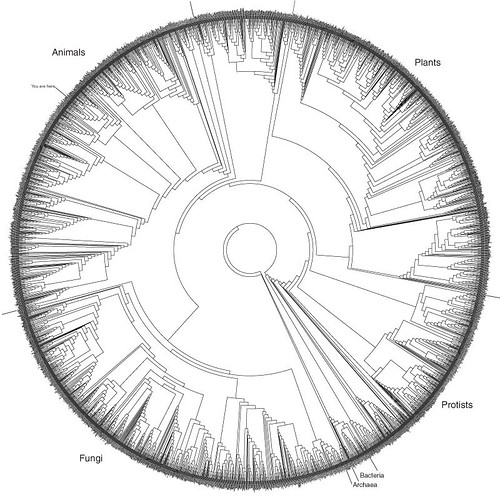 (Image source: Laboratory of David M. Hillis and James J. Bull)
(Image source: Laboratory of David M. Hillis and James J. Bull)In aide of your quest to teach about the natural world and evolution to your kids (and yourself!) try this amazing resource at Berkeley University called
The Berkeley Evolution Project for Teachers.
Phylogeny Glossary:Evolution: Genetic changes in lineages of organisms over time. Through this process, a lineage may split and diversify into new species.
Links to further understanding of Evolution are here and here.
Phylum: is a taxon used in the classification of life, adopted from the Greek phylai the clan-based voting groups in Greek city-states.
WIKI linkPhylogeny: The evolutionary history of a group of organisms.
Any group of species are descended from a common ancestral species, which, over time, split into two species, with these descendents splitting again, and again, until the entire collection of species was produced through evolution and speciation (the splitting of a lineage). The genealogical connections thereby formed in general take the shape of a tree, called the phylogeny of the group.
Link for further understanding of phylogenies
Phylogenetics: The scientific discipline of resolving phylogenetic relationships between organisms.
Species: A leaf on the tree of life. A group of organisms that share a common gene pool as well as a unique evolutionary history distinct from other groups of organisms.
Speciation: The splitting of an evolutionary lineage producing (usually) two new, separate species, which thus begin their own, unique evolutionary histories.
Link for further understanding of Speciation
Taxon: taxon (plural taxa), or taxonomic unit, is a grouping of organisms (named or unnamed). Once named, a taxon will usually have a rank and can be placed at a particular level in a hierarchy.
WIKI linkThis
LINK is an excellent resource for teach evolution, even with
lesson plans!


::
>
Sarcophaga sp. - not your average fly
Sunday, June 18, 2006
The natural world is the best and most therapeutic classroom. When I was a kid I loved sitting next to a plant and sketching it. It really got me in touch with all the minute details and helped me appreciate nature's complexity and flexibility.
I think an important lesson that can come from observing nature is to get a better intuitive understanding of evolution. Living things are the way they are because they became that way versus simply being that way. A child can see that a plant can be perfect in it's symmetry and can be a textbook demonstration of that species but also that a different specimen can be imperfect and one can see how the plant's systems failed in some way.
For those who are not inclined to sit in the hot sun and humidity with pencil and paper, the camera can be an amazing resource for capturing nature.
This morning I caught this little fly outside sipping the morning dew in the shade. He or she is beautiful up close and not a pest at all.
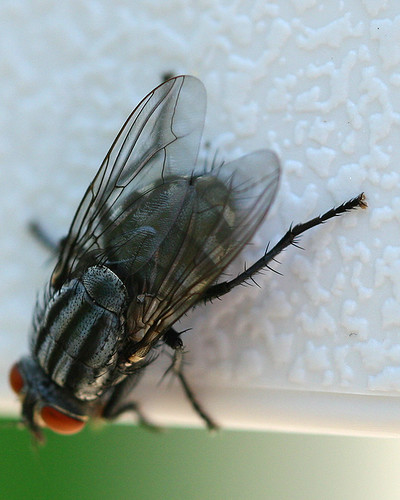
You might notice that our photo shows a fly with 3 stripes on his back while many of the shots I find online of house flies have 4 stripes. Ours is actually a Flesh Fly (Sarcophaga sp.). We have a horse stable near our house so I am guessing this came from there. I used blood meal to fertilize our organic garden pots so they must be going to town on bits of that.
 (Image Source: House fly - Novartis)
(Image Source: House fly - Novartis)Information on the flesh fly can be found at these links:
Identification by Thomas Pape, Curator Ph.D. Zoological Museum, University of Copenhagen
British Insects: the Families of Diptera
National Center for Biotechnology Information Taxonomic Data
The full lineage of this fly is:
Eukaryota; Fungi/Metazoa group; Metazoa; Eumetazoa; Bilateria; Coelomata; Protostomia; Panarthropoda; Arthropoda; Mandibulata; Pancrustacea; Hexapoda; Insecta; Dicondylia; Pterygota; Neoptera; Endopterygota; Diptera; Brachycera; Muscomorpha; Schizophora; Calyptratae; Oestroidea; Sarcophagidae; Sarcophaginae; Sarcophaga
Flesh Fly Wikipedia Entry
For things to learn about the common house fly or Musca domestica Linnaeus, see these links:
Common House Fly at Enchanted Learning
This site has this lovely drawing
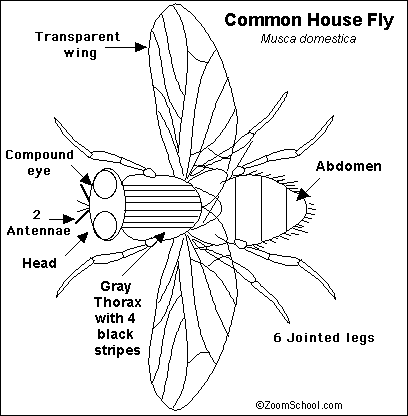
House Fly Wikipedia entry
House Fly life cycle

(Image source: Novartis)
National Center for Biotechnology Information Taxonomic Data
This site tells us that the full lineage of the house fly is:
Eukaryota; Fungi/Metazoa group; Metazoa; Eumetazoa; Bilateria; Coelomata; Protostomia; Panarthropoda; Arthropoda; Mandibulata; Pancrustacea; Hexapoda; Insecta; Dicondylia; Pterygota; Neoptera; Endopterygota; Diptera; Brachycera; Muscomorpha; Schizophora; Calyptratae; Muscoidea; Muscidae; Muscinae; Muscini; Musca; Musca


::
>









